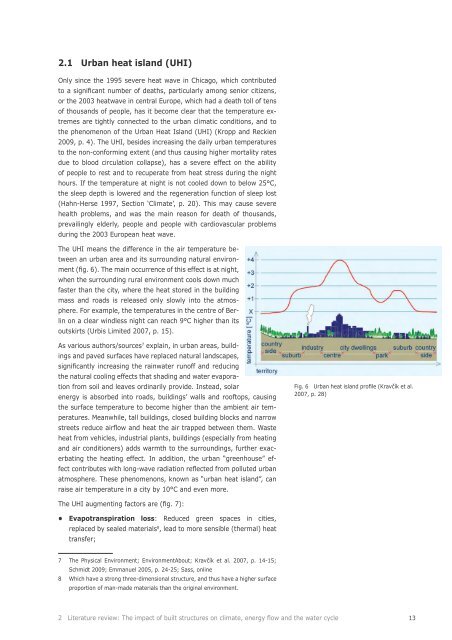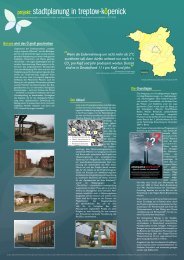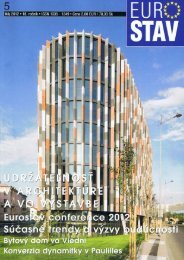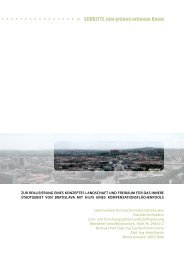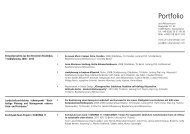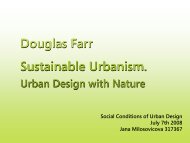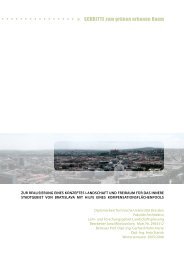Thesis document - Jana Milosovicova - Urban Design English
Thesis document - Jana Milosovicova - Urban Design English
Thesis document - Jana Milosovicova - Urban Design English
- No tags were found...
Create successful ePaper yourself
Turn your PDF publications into a flip-book with our unique Google optimized e-Paper software.
2.1 <strong>Urban</strong> heat island (UHI)Only since the 1995 severe heat wave in Chicago, which contributedto a significant number of deaths, particularly among senior citizens,or the 2003 heatwave in central Europe, which had a death toll of tensof thousands of people, has it become clear that the temperature extremesare tightly connected to the urban climatic conditions, and tothe phenomenon of the <strong>Urban</strong> Heat Island (UHI) (Kropp and Reckien2009, p. 4). The UHI, besides increasing the daily urban temperaturesto the non-conforming extent (and thus causing higher mortality ratesdue to blood circulation collapse), has a severe effect on the abilityof people to rest and to recuperate from heat stress during the nighthours. If the temperature at night is not cooled down to below 25°C,the sleep depth is lowered and the regeneration function of sleep lost(Hahn-Herse 1997, Section ‘Climate’, p. 20). This may cause severehealth problems, and was the main reason for death of thousands,prevailingly elderly, people and people with cardiovascular problemsduring the 2003 European heat wave.The UHI means the difference in the air temperature betweenan urban area and its surrounding natural environment(fig. 6). The main occurrence of this effect is at night,when the surrounding rural environment cools down muchfaster than the city, where the heat stored in the buildingmass and roads is released only slowly into the atmosphere.For example, the temperatures in the centre of Berlinon a clear windless night can reach 9°C higher than itsoutskirts (Urbis Limited 2007, p. 15).As various authors/sources 7 explain, in urban areas, buildingsand paved surfaces have replaced natural landscapes,significantly increasing the rainwater runoff and reducingthe natural cooling effects that shading and water evaporationfrom soil and leaves ordinarily provide. Instead, solarenergy is absorbed into roads, buildings’ walls and rooftops, causingthe surface temperature to become higher than the ambient air temperatures.Meanwhile, tall buildings, closed building blocks and narrowstreets reduce airflow and heat the air trapped between them. Wasteheat from vehicles, industrial plants, buildings (especially from heatingand air conditioners) adds warmth to the surroundings, further exacerbatingthe heating effect. In addition, the urban “greenhouse” effectcontributes with long-wave radiation reflected from polluted urbanatmosphere. These phenomenons, known as “urban heat island”, canraise air temperature in a city by 10°C and even more.Fig. 6 <strong>Urban</strong> heat island profile (Kravčík et al.2007, p. 28)The UHI augmenting factors are (fig. 7):• Evapotranspiration loss: Reduced green spaces in cities,replaced by sealed materials 8 , lead to more sensible (thermal) heattransfer;7 The Physical Environment; EnvironmentAbout; Kravčík et al. 2007, p. 14-15;Schmidt 2009; Emmanuel 2005, p. 24-25; Sass, online8 Which have a strong three-dimensional structure, and thus have a higher surfaceproportion of man-made materials than the original environment.2 Literature review: The impact of built structures on climate, energy flow and the water cycle13


